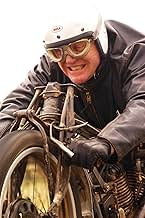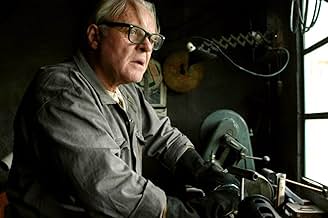यह न्यू ज़ीलैण्ड नागरिक बर्ट मुनरो की कहानी है, जिन्होंने एक 1920 की भारतीय मोटरसाइकिल को फ़िर से बनाने में वर्षों बिताए, जिससे उन्होंने 1967 में उटाह के बोन्नवील साल्ट फ्लैट्स में भूमि पर ग... सभी पढ़ेंयह न्यू ज़ीलैण्ड नागरिक बर्ट मुनरो की कहानी है, जिन्होंने एक 1920 की भारतीय मोटरसाइकिल को फ़िर से बनाने में वर्षों बिताए, जिससे उन्होंने 1967 में उटाह के बोन्नवील साल्ट फ्लैट्स में भूमि पर गति का विश्व रिकॉर्ड बनाया.यह न्यू ज़ीलैण्ड नागरिक बर्ट मुनरो की कहानी है, जिन्होंने एक 1920 की भारतीय मोटरसाइकिल को फ़िर से बनाने में वर्षों बिताए, जिससे उन्होंने 1967 में उटाह के बोन्नवील साल्ट फ्लैट्स में भूमि पर गति का विश्व रिकॉर्ड बनाया.
- पुरस्कार
- 11 जीत और कुल 6 नामांकन
फ़ीचर्ड समीक्षाएं
This film reminded me of "The Straight Story," starring Richard Farnsworth. That dealt with an old man taking a long tractor ride across the state of Iowa to see his dying brother. It featured a bunch of nice characters he met along his journey. This is much the same as we witness Munro's encounters with a variety of people in the United States. Like "The Straight Story," all the people are good people and help our man. That's nice to see.
Once he finally gets to the Salt Flats, however, his problems are far from over as he is unable to meet any of the minimum safety standards. It appears he made his trip for nothing, but, you'll see what happens if you view this movie.
New Zealanders say Hopkins did them proud, too, and they would know if he did a good job or not playing a man from their area of the world, whether he sounded and acted realistically. They say he did.
I enjoyed the first 35 minutes of this story the most. Maybe because that's the most innocent part of the film and features a young boy who looks up to Burt and encourages him when few others are willing to do so.
It's when Munro reaches America where the "nice, clean family film" goes south a bit. He hooks up with transvestites, one-night stands, profanes here and there and the PC angle gets a little overplayed. However, despite making America look a little too weird, everything is done is a tasteful way and it still was a wonderful story. It has to be an inspiration for older folks who might think life's challenges are over once they hit a certain age. Not so, as Mr. Munro shows us in this inspiring, well-photographed film.
This certainly is quite an unknown movie for one which has such a famous actor in the starring role. It's well worth your time, though, to check out.
The main character, New Zealander Bill Munroe as played by Anthony Hopkins, is a true man's man. He has spent his entire adult life tinkering with his streamlined motorcycle, a 1920 Indian (hence the title.) Now in his 60's in the year 1963, he wants to realize his life's dream of taking it halfway around the world to the Bonneville Salt Flats Test Track in Utah, the only place where he can find out how fast it will actually go.
The movie pulls off two often-used themes, The Long Journey and Overcoming Adversity, without a hint of phoniness or melodrama. The Long Journey from New Zealand to Utah takes up most of the movie, with Munroe scrounging up travel money, working off part of his passage on a dilapidated freighter, and the long, event-filled drive from the California coast to Utah in an old used car. Overcoming Adversity is portrayed in two ways: by Munroe's awesome mechanical genius as shown by his ability to fashion spare parts out of almost anything and to improvise a la MacGyver, and in his charm and likability when confronted with more human obstacles. Indeed, one of the movie's chief strengths was the character's ability to make friends easily under any situation, with a cast of colorful supporting characters who wonderfully complemented Hopkins' acting.
After finally reaching the test track, the movie's focus shifts from the acting to the cinematography and drama. The dozens of colorful cars, motorcycles, and drivers' outfits contrast strikingly with the blinding white of the salt flats and the mountainous backdrop. And when Munroe finally gets the chance to make his test run, two questions come to mind. How fast can he go? More importantly, will the 64-year-old man and the 43-year-old patched-up bike hold together under the strain?
After seeing the movie and while still in my euphoric state, my skeptical mind wondered how much of it was actually true. I did a little research, and the portrayal of this amazing man seems to be true enough. Go see this movie; if you do, you'll leave the theater feeling good, and perhaps even a little inspired.
Anthony Hopkins has made a brilliant job of the role, his accent wasn't too bad, and I loved the way he said "Invercarrrrrrgill". Hopkins' talent really shone - without him saying a word or changing his expression, you just knew how Burt felt when confronted by an apparently insurmountable obstacle (I won't spoil it) and his placid acceptance of the inevitable falls, tumbles and injuries told you that for Burt these were a fact of life. The other cast were also flawless, for me there wasn't a weak point in any of the acting. The humour was delivered in the main by Hopkins and with the lightest possible touch. The cinematography was beautiful and conveyed the journey from long quiet light of Munro's idealism in Invercargill, murky 'orribleness of the necessary evil of passing through LA and laying your dream on the line in the harsh open glare of Utah.
Hopkins has done a few of these slightly-disreputable, love-em-when-you-get-to-know-em characters but this is the best. And I'm not a motorcycle fan, and no Kiwi-made-good fan, but I will confess to a tear (almost) at the end when the text came up about Burt's unbeaten record.
If you watch this film at home you won't want to be disturbed by other people talking - you'll want to catch every word, every nuance.
What I got instead was the best film I've seen for quite some time.
Anthony Hopkins totally blew me away. His accent was really very strong (it should be noted that the Invercargil accent is pretty distinct from the rest of the South Island of NZ) and he managed to maintain the audience's interest though some pretty dialogue-heavy scenes. All of the supporting characters did a brilliant job defining a diverse physical and emotional landscape for the protagonist. The cinematography was economical and meaningful and assisted the humorous moments beautifully. The story unfolded very nicely and - thanks to some great editing - the small moments of tension were plentiful and kept the story moving along nicely.
With all the cynicism and politics in contemporary cinema, it is so refreshing to see a film that is very pure, that speaks volumes about kindness and passion and friendship without saying anything at all. This film didn't try to make any big statements, there were no lengthy diatribes about 'acceptance' and 'tolerance', and I loved that.
I left the cinema with a huge grin on my face. I'm so glad I was dragged along for the ride.
क्या आपको पता है
- ट्रिवियाBurt Munro's children visited the set one day, when, according to writer, producer, and director Roger Donaldson, "Tony (Sir Anthony Hopkins) was having a particularly good Burt day." His performance was so authentic that it moved them to tears.
- गूफ़Burt talks about his twin brother and tells Tom a story about how he died as a youngster. The real Burt Munro had a twin sister who died at birth.
- भाव
Tom: Aren't you scared you'll kill yourself if you crash?
Burt Munro: No... You live more in five minutes on a bike like this going flat out than some people live in a lifetime.
- कनेक्शनFeatured in The Daily Show: Anthony Hopkins (2006)
- साउंडट्रैकYou Are My Sunshine
(Jimmie Davis / Charles Mitchell)
© Peer International Corp
Used by permission. All rights reserved
टॉप पसंद
- How long is The World's Fastest Indian?Alexa द्वारा संचालित
विवरण
- रिलीज़ की तारीख़
- कंट्री ऑफ़ ओरिजिन
- आधिकारिक साइट
- भाषा
- इस रूप में भी जाना जाता है
- El amo del viento
- फ़िल्माने की जगहें
- उत्पादन कंपनियां
- IMDbPro पर और कंपनी क्रेडिट देखें
बॉक्स ऑफ़िस
- बजट
- $2,50,00,000(अनुमानित)
- US और कनाडा में सकल
- $51,28,124
- दुनिया भर में सकल
- $1,83,02,013
- चलने की अवधि
- 2 घं 7 मि(127 min)
- रंग
- ध्वनि मिश्रण
- पक्ष अनुपात
- 2.35 : 1

































